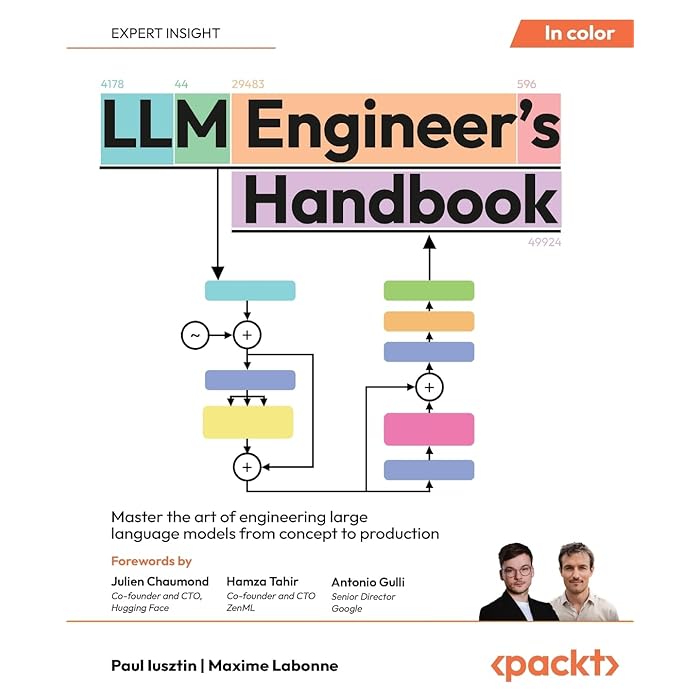Description
An “LLM Engineer’s Handbook” would likely serve as a guide for engineers working with large language models (LLMs) like GPT (or others), providing insights into how these models work, how to fine-tune or customize them, how to deploy them, and how to address challenges such as ethical concerns, scaling issues, and performance optimization. Below is a conceptual outline for such a handbook, divided into key sections.
—
### **LLM Engineer’s Handbook**
#### **Part 1: Introduction to Large Language Models (LLMs)**
– **What are LLMs?**
– Definition and explanation of large language models.
– Key capabilities (e.g., text generation, summarization, translation).
– Use cases across different industries (healthcare, finance, customer service, etc.).
– **History and Evolution of LLMs**
– Overview of important milestones in LLM research (e.g., GPT-2, GPT-3, BERT, T5, etc.).
– The role of transformer architectures in LLM development.
– The importance of pre-training and fine-tuning.
– **Key Components of an LLM**
– Tokenization and embeddings.
– Attention mechanisms and transformers.
– Pre-training objectives (e.g., autoregressive vs. masked language models).
– Fine-tuning and task-specific training.
—
#### **Part 2: Setting Up and Training LLMs**
– **Choosing the Right Framework**
– Overview of popular frameworks for building and deploying LLMs (e.g., Hugging Face Transformers, OpenAI API, TensorFlow, PyTorch).
– Comparison of open-source models and commercial offerings.
– **Data Preparation**
– Collecting and cleaning text data for training.
– Data augmentation strategies.
– Handling biased, toxic, or low-quality data.
– Balancing dataset size vs. quality.
– **Training an LLM from Scratch vs. Fine-tuning**
– When to train from scratch and when to fine-tune.
– Hyperparameter tuning.
– Distributed training and handling large-scale datasets.
– Using pre-trained models to save resources.
– **Training Infrastructure**
– Hardware requirements (GPUs, TPUs, distributed systems).
– Cloud solutions (e.g., AWS, Google Cloud, Azure).
– Considerations for scaling up training processes.
—
#### **Part 3: Fine-tuning and Customizing LLMs**
– **Understanding Fine-tuning**
– What fine-tuning is and why it is important.
– Techniques for domain adaptation.
– Transfer learning and using small labeled datasets effectively.
– **Prompt Engineering**
– Introduction to prompt engineering for LLMs.
– How to design effective prompts.
– Techniques like few-shot and zero-shot learning.
– Customizing prompts for specific applications (e.g., chatbots, code generation).
– **Evaluation and Validation**
– Methods to evaluate model performance (accuracy, perplexity, etc.).
– Creating a robust validation set.
– Use of evaluation metrics for specific tasks (e.g., ROUGE for summarization, BLEU for translation).
—
#### **Part 4: Scaling and Deploying LLMs**
– **Optimizing for Efficiency**
– Model pruning and quantization.
– Techniques like knowledge distillation.
– Latency and throughput considerations in real-time applications.
– **Deployment Strategies**
– Cloud-based deployment (using platforms like AWS Sagemaker, Google AI Platform, or Azure ML).
– On-premise deployment for privacy-sensitive applications.
– Serverless and microservice architectures.
– Deploying LLMs as APIs or integrating them into existing software solutions.
– **Handling User Interactions**
– Chatbot deployment and conversational agents.
– Integrating LLMs into voice assistants (e.g., Alexa, Google Assistant).
– Feedback loops and continuous improvement.
– **Monitoring and Maintenance**
– Tracking model performance over time.
– Monitoring for model drift and retraining triggers.
– Updating and patching models for evolving language patterns.
—
#### **Part 5: Ethics, Safety, and Governance**
– **Bias and Fairness in LLMs**
– Types of bias in language models (e.g., gender, racial, geographic).
– Techniques for mitigating bias during training.
– Fairness metrics and their importance.
– **Ethical Considerations**
– Avoiding harmful content generation (e.g., misinformation, hate speech).
– Privacy concerns and ensuring user data protection.
– Ethical guidelines for model use (e.g., ensuring responsible AI deployment).
– **Security Risks and Mitigations**
– Adversarial attacks on LLMs (e.g., prompt injection).
– Detecting and preventing harmful outputs.
– Safeguarding user data when using LLMs in production systems.
– **Explainability and Transparency**
– Techniques for explaining LLM decisions (e.g., attention visualization).
– Importance of transparency in model outputs and limitations.
—
#### **Part 6: Advanced Topics and Future Directions**
– **Multi-modal Models**
– Overview of multi-modal models like CLIP (text + image), GPT-4’s multimodal capabilities, and vision-language models.
– Integrating LLMs with vision, audio, and other data types.
– **Zero-shot and Few-shot Learning**
– Understanding how LLMs can handle tasks with minimal data.
– Best practices for leveraging pre-trained models for unseen tasks.
– **AI Alignment and the Future of LLMs**
– Current research on aligning LLMs with human values and intentions.
– The impact of LLMs on the future job market, education, and other sectors.
– Ethical AI governance and regulation.
– **Next-Generation LLMs**
– Theoretical and practical advancements in model architecture (e.g., transformers vs. other architectures).
– Scaling up LLMs further: beyond GPT-4 and into GPT-5, etc.
– Environmental concerns with the carbon footprint of large models.
—
#### **Part 7: Case Studies and Real-World Applications**
– **Case Study 1: Healthcare**
– Building a medical assistant using LLMs.
– Challenges in medical language processing and data privacy concerns.
– **Case Study 2: Legal Industry**
– Automating legal document review with LLMs.
– Ethical considerations in legal advice generation.
– **Case Study 3: Customer Support and Virtual Assistants**
– Scaling customer service with AI-driven chatbots.
– Managing user expectations and maintaining quality.
– **Case Study 4: Content Creation**
– Using LLMs in creative writing, marketing, and entertainment.
– Addressing copyright issues and maintaining originality.
—
#### **Part 8: Resources and Further Reading**
– **Key Papers and Articles**
– Important research papers in LLM development.
– Books and online courses to deepen understanding.
– **Tools and Libraries**
– Overview of key tools (e.g., Hugging Face Transformers, spaCy, OpenAI API).
– Additional libraries for NLP tasks (e.g., NLTK, AllenNLP, DeepPavlov).
– **Communities and Conferences**
– Online communities for LLM engineers (e.g., forums, GitHub repositories).
– Key conferences (e.g., NeurIPS, ACL, ICLR, ICML).
—
### Conclusion
The “LLM Engineer’s Handbook” would aim to provide a comprehensive, hands-on guide for engineers working with large language models, covering everything from the basics of model architectures to the practical aspects of deployment and ethics. It would serve both as a reference for beginners and a deeper resource for experienced practitioners.





Reviews
There are no reviews yet.